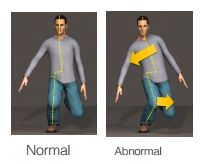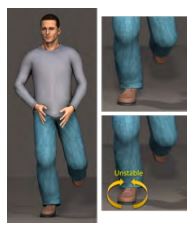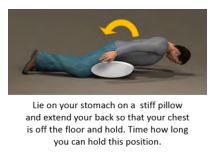Easy Lower Back and Knee Instability Tests You Can Do at Home
On this page:
How do you know if you have a knee stability problem? You may have popping or cracking in your knee joint or may feel sudden shifts. For example, when performing cutting exercises, you may feel your knee “give way.”
There may be no obvious sense of instability or popping/cracking in the knee, but you may have joint pain or swelling after activity, which could be signs of smaller amounts of microinstability. We have assembled these easy knee stability tests you can perform at home to help you determine if you have good or poor knee stability.
2 Knee Instability Tests
The stability of the knee can be directly impacted by the spine and ankle, so these quick and straightforward tests, taken from the “Stability” chapter in Orthopedics 2.0, will also evaluate the stability of the lower spine and ankle. If your tests only indicate instability in the knee, your knee is likely the primary problem. If your tests show instabilities in both the spine and the knee, your spine may be the main cause of your knee instability.
You should be a participant in your recovery, so it’s a good idea to take these tests on a monthly basis when you are being treated. If you’re a Regenexx patient, before your first evaluation, please take the test, print out the worksheet, and bring it to your initial assessment.
If you’re not a patient, you can take the test and use the worksheet to record where you are at any given time. Click here for a printer-friendly version of the worksheet (this worksheet includes shoulder and neck tests as well).
Caution! These tests may cause injury or exacerbate the conditions of patients who have a more fragile stability system or who are at a lower level in their stability. Please do not attempt these if you get injured easily.
If you do decide to perform this assessment, if you get significant pain during any given test, stop immediately. You are performing these tests at your risk. If you have pain with any of these movements or discover an instability, we recommend you seek treatment.
For some of these tests, you’ll need an assistant. You’ll also need a timer or clock/watch with a second hand (there are good stopwatch programs on most smartphones).
Knee Test 1: Single-Leg Deep-Knee Bend
This is a single test for hip and knee stability as both of these are linked.
Stand and then balance on one foot (the side you want to test). Perform a single-leg squat while trying to keep your body as straight as possible.
If you’re able to balance so that you’re knee is straight about your hip for about one-half of the deep knee bend and the return up, then you pass the test on that side.
If you must tilt your body over to that side and/or your knee drives inward, you have poor hip and knee stability and fail the test. If you can’t perform the half squat, you fail as well.
Knee Test 2: Single-Leg Balance
You can also test the ankle and its potential impact on the stability of the knee from the same standing-on-one-leg position.
Count to 10 while balancing on one leg, and watch your ankle. With your body straight (which is again measuring your hip stability) and hands to your sides, does the ankle roll or have to move back and forth during that 10 seconds?
If so, you may have an unstable ankle. If not, and the ankle remains rock solid for the 10 seconds, you pass this test.
If you have a tough time with this, you may have an ankle stability issue. This can impact stability all the way up to the knee and can even, in some patients, cause a kneecap problem.
2 Lower Back Instability Tests
Lower Back Test 1: 90-Degree Sit-Up
There are two stability tests for the lower back; both pioneered by a Japanese researcher. The first is a simple sit-up maneuver.
Lie faceup and bring your hips and knees to a 90-degree position as shown. Make sure you keep your neck flexed. Set a timer and hold this position.
The standard time for men is 182 seconds (3 minutes), and for women, it’s 85 seconds (1.5 minutes).
If you experience significant pain with this maneuver, stop! If you have a lot of pain with this maneuver, you may have a disc pain or nerve issue as flexion places more pressure on the disc. Pressure on the disc could also affect the nerves leading to the knees and possibly cause a knee stability issue.
Scoring: Write down your timed score.
Lower Back Test 2: Back Extension
The second lower back test evaluates the low-back extensors.
Lie facedown on the floor and place a firm pillow under your stomach with your hands at your sides. The pillow should be firm enough or doubled up so that you can extend your back and lift your chest off the floor as shown. Your neck should remain flexed. Set a timer and hold this position.
For men, the normal hold is 208 seconds (3.5 minutes), and for women, it’s 124 seconds (2 minutes).
If you experience significant pain with this maneuver, stop! If you have pain with extension like this, you may have either a facet or lumbar stenosis problem, either of which can affect the nerves leading to the knees and possibly cause a knee stability issue.
What if I Failed Some of These Tests?
If you failed one or more tests, it means you have poor stability in these areas. This could be due to pain shutting down muscles, weak muscles, or irritated nerves that make them weaker or misfire. If it’s pain, then you have to find and fix the source of that problem. If it’s weak muscles, they may just need strengthening.
Knee stability exercises are commonly taught in many physical therapy programs. The Kinesio Taping programs (look up McConnell Taping Techniques) are a good bet for kneecap pain and combine taping to provide better proprioceptive feedback from the joint being trained. This method can also be used for other joints.
Finally, if its irritated nerves, no amount of getting the muscles stronger will help; you need to reduce the nerve irritation. As you get treated, use these knee stability tests as your monthly spot-check to gage your progress. The goal is to increase your scores in each problem area.
The upshot? Knee stability is critical to avoid arthritis. These simple tests will help you get a sense of whether you have an issue. If there’s a problem, starting with a good physical therapist may help. In the meantime, read my book Orthopedics 2.0.
—————————————
References
(1) Monk AP, Davies LJ, Hopewell S, Harris K, Beard DJ, Price AJ. Surgical versus conservative interventions for treating anterior cruciate ligament injuries. Cochrane Database Syst Rev. 2016;4(4):CD011166. Published 2016 Apr 3. doi:10.1002/14651858.CD011166.pub2
(2) Iijima H, Suzuki Y, Aoyama T, Takahashi M. Interaction between low back pain and knee pain contributes to disability level in individuals with knee osteoarthritis: a cross-sectional study. Osteoarthritis Cartilage. 2018;26(10):1319-1325. doi:10.1016/j.joca.2018.06.012

If you have questions or comments about this blog post, please email us at [email protected]
NOTE: This blog post provides general information to help the reader better understand regenerative medicine, musculoskeletal health, and related subjects. All content provided in this blog, website, or any linked materials, including text, graphics, images, patient profiles, outcomes, and information, are not intended and should not be considered or used as a substitute for medical advice, diagnosis, or treatment. Please always consult with a professional and certified healthcare provider to discuss if a treatment is right for you.




